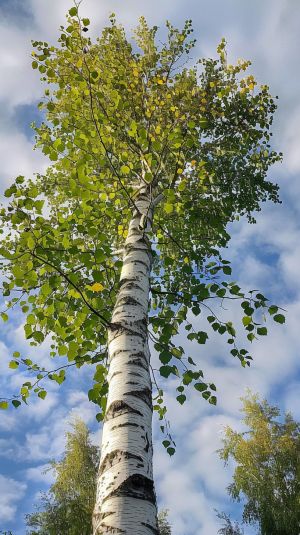Silver Birch
The Silver Birch, scientifically known as Betula pendula, is a deciduous hardwood tree native to the British Isles and much of Europe and parts of Asia. Known for its striking white bark and graceful form, the silver birch is not only a staple of natural landscapes but also holds significant value in both traditional and magical contexts. While not inherently magical, silver birches growing in areas of strong ley energy can become quasi-magical, absorbing this energy and becoming useful in various magical crafts.
With its ethereal beauty and ecological importance, the Silver Birch has also carved out a niche in the magical traditions of the British Isles. While any Silver Birch can bring natural charm to a landscape, those bathed in the energies of ley lines hold a special place in the heart of practitioners of magic, bridging the gap between the earthly and the mystical.
Appearance
The Silver Birch stands out with its distinctive, often peeling white bark, which can develop black fissures as the tree ages. It has a slender, elegant profile, with branches that droop slightly, giving it a weeping habit. The leaves are small, triangular to diamond-shaped, with a fine, serrated edge, turning a vivid yellow in autumn before falling. In spring, the tree produces catkins, which are long and yellow for males and shorter and green for females.
Infused Silver Birch trees can be identified by a slight blue-ish to silver shimmer on the leaves. Its wood will display a similar effect.
Habitat
Silver Birch trees are adaptable and can thrive in a wide range of habitats, from dry heaths to wetter moorlands. They are pioneer species, often among the first to colonize open ground, thanks to their wind-dispersed seeds.
Preferring light, well-drained soils, Silver Birches can grow in sandy and acidic conditions where other trees might struggle. They enjoy plenty of sunlight and are often found in open woodland, on heathlands, and at the edges of forests. Despite their preference for drier soils, they can also be found in damp conditions but may not grow as vigorously. Their ability to grow in poor soils and regenerate quickly after disturbances like fire makes them an essential part of forest ecosystems.
Uses in Magic
While the Silver Birch is not inherently magical, its quasi-magical properties emerge when it grows near strong ley lines, where the earth's natural magical energy is pronounced. Such infused trees can be identified by their leaves glowing blue in the darkness, giving them an aetheral, otherworldly appearance. Wood from an energy-infused Silver Birch is highly sought after for crafting wands and talismans, believed to channel magical energy with exceptional clarity and strength. The sap, especially from magically infused trees, is used in the creation of elixirs and potions, valued for its purifying and enhancing qualities. These magical beverages are said to promote clarity of thought, enhance magical perception, and sometimes serve as a base for more complex magical concoctions.


